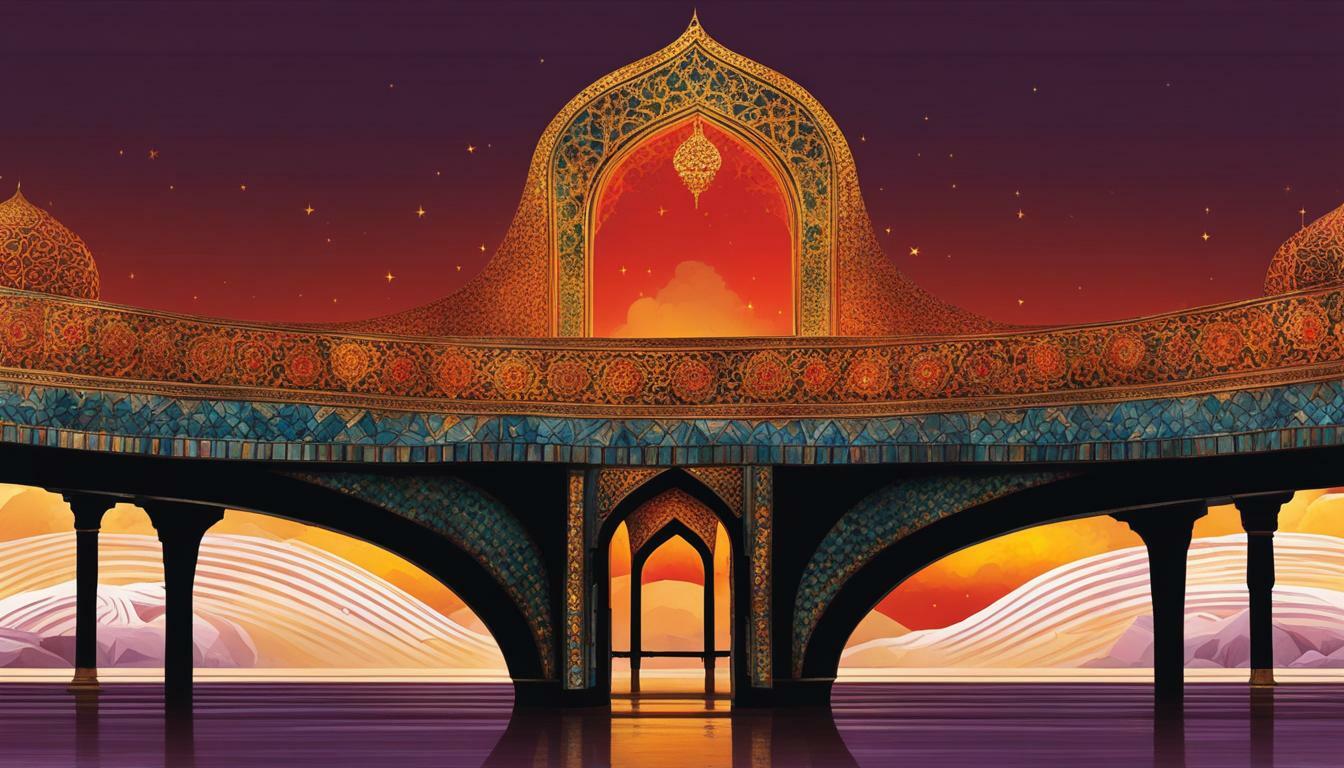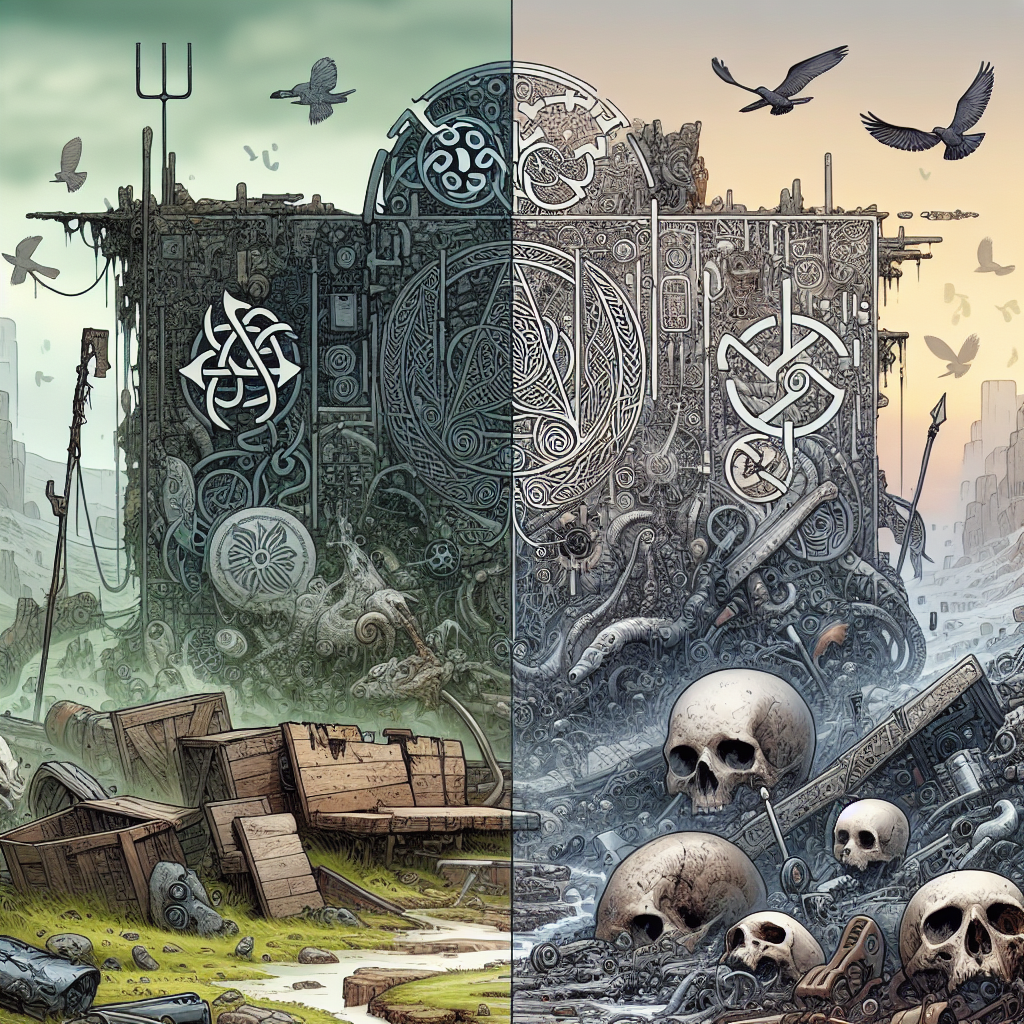The Chinvat Bridge in Zoroastrianism and the Sirat in Islam are both important concepts that represent the bridge between the world of the living and the afterlife in their respective religions. These spiritual beliefs hold significant meaning for followers, offering insights into the judgment and journey that await them beyond death.
Key Takeaways:
- The Chinvat Bridge is a bridge that all souls must cross upon death in Zoroastrianism, where judgment takes place.
- The appearance of the Chinvat Bridge varies depending on a person’s righteousness, with wider bridges symbolizing a virtuous life and narrower bridges representing wickedness.
- The Sirat in Islam is a broad path that the faithful will easily traverse on their way to heaven, while non-Muslims and unbelievers may fall from it.
- The Chinvat Bridge and the Sirat have similar roles in their respective religions, acting as a gateway to the afterlife and determining one’s fate based on their actions in life.
- Both concepts hold deep significance for followers, serving as reminders of the importance of leading a righteous and virtuous life.
As we explore the Chinvat Bridge in Zoroastrianism and the Sirat in Islam in more detail, we will uncover the unique features of each concept and gain a deeper understanding of the different beliefs surrounding the journey to the afterlife.
Chinvat Bridge in Zoroastrianism Explained
In Zoroastrianism, the Chinvat Bridge is a crucial concept that symbolizes the journey between the mortal realm and the afterlife, and it plays a significant role in the final judgment of a person’s soul. According to Zoroastrian beliefs, upon death, all souls must cross this bridge, where their deeds and intentions are evaluated by divine beings. The appearance of the bridge is determined by the righteousness of the individual, reflecting the balance between their good and evil actions during their lifetime.
If a person’s thoughts, words, and deeds lean towards wickedness, the Chinvat Bridge will appear narrow and treacherous. These individuals will be dragged into Zoroastrian hell, where they will face punishment for their transgressions. On the other hand, for those who have led a righteous life and have accumulated good deeds, the bridge will widen, allowing them to cross to the other side and be united with Ahura Mazda, the supreme deity, in the highest heaven.
This concept of judgment and the role of the Chinvat Bridge in determining one’s fate underscores the importance of leading a morally upright life in Zoroastrianism. It serves as a reminder of the consequences of one’s actions, emphasizing the need for individuals to cultivate virtuous thoughts, speak kind words, and engage in benevolent acts to ensure a favorable outcome in the afterlife.
To summarize, the Chinvat Bridge is a sacred symbol in Zoroastrianism, representing the passage between life and death, where the righteousness of an individual is assessed. Its appearance mirrors the moral integrity of the individual, with a wide bridge leading to heavenly union for the virtuous and a narrow bridge leading to punishment for the wicked. This concept serves as a moral guide, encouraging believers to strive for righteousness in their thoughts, words, and actions.
| Concept | Chinvat Bridge in Zoroastrianism | |
|---|---|---|
| Symbolizes | Journey between mortal realm and afterlife | |
| Appearance | Narrow and treacherous | Wide and passable |
| Outcome for the wicked | Dragged into Zoroastrian hell | |
| Outcome for the righteous | United with Ahura Mazda in highest heaven | |
Sirat in Islam Explained
The Sirat is an important aspect of Islamic teachings, representing a path that the believers must traverse on their way to heaven with Allah and other prophets. It serves as a means of testing the faith and obedience of the followers, separating the true believers from the non-Muslims and unbelievers. In Islam, it is believed that all souls will have to cross the Sirat on the Day of Judgment, which is a day of reckoning when each person’s actions in life will be accounted for.
Described as sharper than a sword and thinner than a hair, the Sirat poses a great challenge, especially for those who have strayed from the path of righteousness. It requires balance, steadfastness, and unwavering faith to successfully cross the Sirat and enter paradise. Only those who have adhered to the teachings of Islam and lived a virtuous life will be able to navigate the path with ease and reach their heavenly destination.
The beliefs surrounding the Sirat in Islam emphasize the importance of leading a righteous life and following the teachings of the Quran. It serves as a reminder that actions have consequences and that the choices made in this life will ultimately determine one’s fate in the afterlife. The Sirat serves as a test of faith and devotion to Allah, separating the true believers from those who have strayed from the path of Islam.
As mentioned in the Quran, “And We will test you with evil and with good as trial; and to Us you will be returned” (Surah Al-Anbiya, 21:35). This verse highlights the belief that the Sirat is a means of testing the believers’ faith and devotion and that those who pass the test will be rewarded with eternal paradise in the presence of Allah.
| Key Points: | Summary |
|---|---|
| Concept | The Sirat represents a path that Muslims must traverse on their way to heaven with Allah and other prophets. |
| Challenge | The Sirat is described as sharper than a sword and thinner than a hair, posing a great challenge for the believers. |
| Importance | The Sirat serves as a test of faith and devotion, separating the true believers from those who have strayed from the path of Islam. |
| Beliefs | Believers must lead a righteous life, follow the teachings of the Quran, and have unwavering faith to successfully cross the Sirat. |
Comparison of Chinvat Bridge and Sirat
While both the Chinvat Bridge in Zoroastrianism and the Sirat in Islam serve as bridges to the afterlife, there are significant differences in their appearances and the outcomes for the souls who cross them.
In Zoroastrianism, the Chinvat Bridge is said to take on different forms depending on the righteousness of the individual. For those who have led a wicked life, the bridge appears narrow and treacherous, dragging them towards Zoroastrian hell. On the other hand, for those who have lived a righteous life with numerous good thoughts, words, and deeds, the bridge widens enough for them to cross over and be united with Ahura Mazda in the highest heaven.
Conversely, the Sirat in Islam is described as a broad and easy path that the faithful will effortlessly traverse, leading them to paradise with Allah and the prophets. However, those who are non-Muslims or unbelievers will face a much harsher fate. The Sirat becomes sharper than a sword and thinner than a hair for them, causing them to fall off into eternal damnation.
In essence, while both the Chinvat Bridge and the Sirat serve as passages to the afterlife, the Chinvat Bridge is a test of one’s moral character and righteousness, determining their ultimate destination, while the Sirat in Islam serves as a clear path for the faithful and a treacherous one for the non-believers.
| Chinvat Bridge in Zoroastrianism | Sirat in Islam |
|---|---|
| Appears narrow or wide based on individual’s righteousness | Broad and easy path |
| Leads to various destinations based on individual’s moral character | Leads to paradise for the faithful, eternal damnation for non-believers |
| Represents a test of one’s actions and deeds in life | Serves as a clear path for the faithful |
Chinvat Bridge in Zoroastrianism Concept
The concept of the Chinvat Bridge in Zoroastrianism represents the idea of crossing from the mortal realm to the afterlife and stands as a symbol of the final judgment of a person’s soul. This bridge serves as a dividing line between the world of the living and the spiritual realm, where souls are assessed based on their thoughts, words, and actions during their earthly existence.
According to Zoroastrian belief, the appearance of the Chinvat Bridge is unique to each individual, reflecting their moral worthiness. For those who have lived a virtuous life, the bridge widens, offering a smooth passage to the heavenly realm of Ahura Mazda. Conversely, those who have committed wicked deeds will face a narrow and treacherous bridge, ultimately leading them to the depths of Zoroastrian hell.
This concept serves as a reminder of the importance of leading a righteous and ethical life according to Zoroastrian teachings. It highlights the belief that one’s choices and actions in this world have consequences in the afterlife, and that the judgment that takes place on the Chinvat Bridge will determine the eternal fate of the soul.
| Zoroastrian Beliefs | Chinvat Bridge |
|---|---|
| Bridge between mortal realm and afterlife | Symbol of final judgment |
| Appearance varies based on morality | Wide for the righteous, narrow for the wicked |
| Leads to heavenly realm or Zoroastrian hell | Reflection of a person’s choices and actions |
Sirat in Islam Teachings
The teachings surrounding the Sirat in Islam emphasize the importance of a righteous life and the consequences that non-Muslims and unbelievers may face when crossing the path to heaven. In Islam, it is believed that the Sirat is a bridge that connects the earthly realm to the afterlife, and only those who have lived virtuous lives will be able to traverse it successfully.
According to Islamic teachings, the Sirat is described as being sharper than a sword and thinner than a hair. This description symbolizes the difficulty of crossing the path for those who have not adhered to the teachings of Islam. Non-Muslims and unbelievers will find the Sirat extremely treacherous and will inevitably fall from it into the depths of hell.
In contrast, devout Muslims who have followed the path of righteousness will be granted the ability to cross the Sirat with ease. Their purity of heart and adherence to the teachings of the Quran and the Prophet Muhammad will enable them to navigate the path and reach paradise, where they will be reunited with Allah and other prophets.
The teachings of Islam regarding the Sirat serve as a reminder of the importance of leading a virtuous life and following the principles set forth in the Quran. It emphasizes the consequences that await those who stray from the path of righteousness and highlights the eternal rewards that await the faithful who remain steadfast in their devotion.
| Key Teachings of Sirat in Islam |
|---|
| The Sirat is a bridge connecting the earthly realm to the afterlife. |
| Non-Muslims and unbelievers face the risk of falling from the Sirat into hell. |
| Devout Muslims who have lived a virtuous life will be able to cross the Sirat and reach paradise. |
| The teachings of Islam emphasize the importance of leading a righteous life and following the principles of the Quran. |
Conclusion
In conclusion, while both the Chinvat Bridge in Zoroastrianism and the Sirat in Islam serve as bridges to the afterlife, they differ significantly in their appearance, judgment process, and outcomes for the souls who cross them.
The Chinvat Bridge, as depicted in Zoroastrianism, is a narrow or wide span that represents the transition between the world of the living and the afterlife. Its appearance varies based on the righteousness of the individual. For the wicked, the bridge is narrow, and they are dragged into Zoroastrian hell. However, for the virtuous, the bridge widens, allowing them to cross and be united with Ahura Mazda in the highest heaven.
On the other hand, the Sirat in Islam is depicted as a broad path that the faithful traverse effortlessly on their way to heaven, alongside Allah and other prophets. However, for non-Muslims and unbelievers, the Sirat becomes sharper than a sword and thinner than a hair, causing them to fall from the path and face the consequences of their disbelief.
These distinct differences highlight the contrasting beliefs and perspectives between Zoroastrianism and Islam regarding the afterlife. While Zoroastrianism emphasizes the importance of good thoughts, words, and deeds in order to successfully cross the bridge and attain paradise, Islam emphasizes faith and adherence to the teachings of the Quran and the Prophet Muhammad in order to traverse the Sirat and reach eternal bliss.
FAQ
What is the Chinvat Bridge in Zoroastrianism?
The Chinvat Bridge is a concept in Zoroastrianism that represents the span between the world of the living and the afterlife. It is the bridge that all souls must cross upon death, where they are judged and assigned a place in the afterlife.
How does the Chinvat Bridge appear to different individuals?
The appearance of the Chinvat Bridge varies depending on the righteousness of the observer. If a person has been wicked, the bridge will appear narrow and they will be dragged into Zoroastrian hell. If a person’s good thoughts, words, and deeds are many, the bridge will be wide enough to cross, and they will be united with Ahura Mazda in the highest heaven.
What is the Sirat in Islam?
In Islam, the Sirat is the equivalent concept to the Chinvat Bridge. It is a broad path that the faithful will move easily across on their way to heaven with Allah and other prophets.
What happens to non-Muslims and unbelievers on the Sirat?
Non-Muslims and unbelievers will fall from the Sirat, as it becomes sharper than a sword and thinner than a hair.
 Skip to main content
Skip to main content


